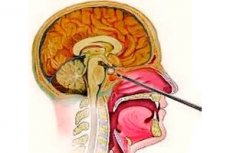Medical expert of the article
New publications
Pituitary adenomectomy.
Last reviewed: 04.07.2025

All iLive content is medically reviewed or fact checked to ensure as much factual accuracy as possible.
We have strict sourcing guidelines and only link to reputable media sites, academic research institutions and, whenever possible, medically peer reviewed studies. Note that the numbers in parentheses ([1], [2], etc.) are clickable links to these studies.
If you feel that any of our content is inaccurate, out-of-date, or otherwise questionable, please select it and press Ctrl + Enter.

Pituitary adenoma is a benign tumor that affects the pituitary gland. The pathology of this organ accounts for approximately 20% of cases. The peculiarity of this disease is that it is often asymptomatic. Such pathology is detected mainly by chance. At the same time, timely diagnosis is important, since only in the early stages can the adenoma be successfully and fairly quickly cured.
The tumor grows slowly and has the ability to compress surrounding tissues. This leads to serious neurological disorders that can be life-threatening for the patient. It often ends in disability or death (in the absence of adequate and timely treatment).
The specifics of the treatment of this disease are determined by the type of the disease, the nature and size of the neoplasm, and its sensitivity to a particular type of exposure. Drug therapy, hormone replacement therapy, surgery, and radiation therapy are used. Surgical treatment methods are used if other methods are ineffective. Removing a pituitary adenoma is quite difficult, since it is located near important structures of the brain. There are also difficulties in surgical access to the adenoma itself. Only a neurosurgeon can make a conclusion about the advisability of removing the neoplasm after a thorough study of the patient's medical history and examination. It is also necessary to obtain all the necessary characteristics of the tumor.
Modern neurosurgery has various minimally invasive methods for removing adenoma. In many cases, this makes it possible to avoid traumatizing surrounding tissues. Also, due to the possibility of avoiding craniotomy, the risk of complications is significantly reduced. Today, various minimally invasive endoscopic methods are widely used. In particular, such a method as remote tumor removal using a cyber knife is also practiced.
A characteristic feature is that the operation is performed using transnasal access. In this case, the surgeon inserts a probe through the nasal passage. The removal process itself is monitored on the monitor. The advantage of the method is that it does not require incisions and opening the skull. The effectiveness of this treatment method is 90% for small tumors. If the tumor is large, the probability of a successful outcome is sharply reduced. Thus, there is no doubt about the need for early diagnosis.
Transsphenoidal adenomectomy
Transsphenoidal adenomectomy is a modern and highly effective method of surgical treatment of adenoma. Its effectiveness is approximately 84%, which is quite a lot for surgery. At the same time, the risk of complications is reduced to a minimum. At the same time, the effectiveness and safety of the procedure can be compared with endoscopic treatment techniques.
It is an invasive technique that allows visualization of the wound surface, provides a high overview. The level of manipulative capabilities also increases significantly. This allows for a lower level of trauma, reducing the risk of damage to surrounding tissues. As a result, recovery occurs much faster, the operation is easier to tolerate. Ultimately, the number of days spent in the hospital is significantly reduced. The period of incapacity for work is also significantly reduced. The duration of postoperative treatment and preliminary preoperative preparation is sharply reduced.
The disadvantages of this method include insufficient visibility of the surgical field in volume. This disadvantage can be eliminated by improving endoscopic equipment. In particular, it is necessary that it provides a volumetric view of the surgical field.

